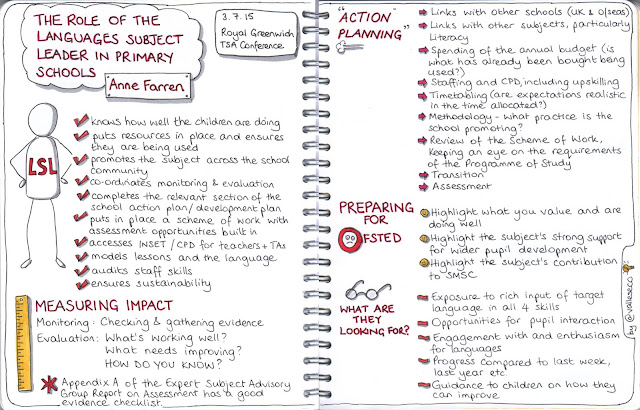I'm a Languages teacher and independent consultant who changed to Primary after 14 years of Secondary teaching. Read about my creative ideas for language teaching, suitable for more than just primary.
Monday, 20 July 2015
Storytelling with children
With many thanks to Sylvie Bartlett Rawlings, who recommended this book. It is packed with useful tips for using stories in the Languages classroom, as well as examples of stories that can be used, and basic lesson plans to go with them. Some of these stories are suitable for adapting for the Key Stage 2 setting.
Monday, 13 July 2015
Arts and Crafts
Click on the image to see it bigger.
Labels:
art,
book,
craft,
sketchnoting
Monday, 6 July 2015
In defence of minibooks
I have been talking to a lot of teachers about minibooks recently. All those who see them are inspired and can think of lots of ways that they can use them in their own classroom to promote reading, writing, dictionary skills and even speaking.
Some teachers have asked me if I have any advice for how they can justify doing minibooks to any line managers, SLT, people observing their lessons etc.. Some say that they have been criticised for having the making of the minibooks cut into the learning time, others that children would be better off spending the time doing "proper work".
So why are minibooks A Good Thing?
- They enable children to be creative, artistically and linguistically.
- They are small and non-threatening, unlike a piece of file paper or the blank page of an exercise book.
- They motivate children to read and write.
- They make brilliant displays.
- Children can easily take them home to share with the wider school community.
- They are easy to post to a partner school in the UK or overseas.
- They contribute to the enjoyment of language learning.
- Minibooks often promote intercultural understanding (such as the Aztec Codex).
- They can be used to provide tailor-made reading material for classes.
- They make a nice change for Year 6!
- They enable part of the KS2 Art and Design curriculum to be met.
- They oblige children to listen to and follow instructions.
- They promote a culture of co-operation and helping in the classroom.
- Making minibooks promotes manual dexterity and fine motor skills.
- Children feel proud of something they have made, written and illustrated themselves.
- Once children have learned how to make a certain kind of minibook they often go on to make them in their own time and write about things they are learning in different areas of the curriculum.
- It's nice for children to have a break from tech sometimes.
Please leave a comment if you can think of any other reasons!
Saturday, 4 July 2015
Sketchnotes from Greenwich
Yesterday I had the pleasure of travelling once again to my home town, this time to deliver my minibook workshop at the Royal Greenwich Teaching Schools Alliance Conference. I enjoyed hearing four speakers who I hadn't heard before and catching up with friends.
Here are my sketchnotes from the day. Even though I caught the first train out of the north-east at 5.40am, I didn't arrive in Greenwich until about 9.40 and so missed most of Dr Colin Christie's keynote about spontaneous speech.
And here's a bonus one, of the Instituto Cervantes' El español: lengua viva report, which came out this week.
Here are my sketchnotes from the day. Even though I caught the first train out of the north-east at 5.40am, I didn't arrive in Greenwich until about 9.40 and so missed most of Dr Colin Christie's keynote about spontaneous speech.
 |
| Professor Alison Mackey, Vice Chair of Linguistics, Georgetown University |
 |
| Professor Ernesto Macaro, Oxford University |
And here's a bonus one, of the Instituto Cervantes' El español: lengua viva report, which came out this week.
Subscribe to:
Comments (Atom)







